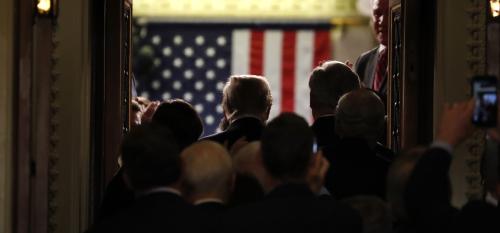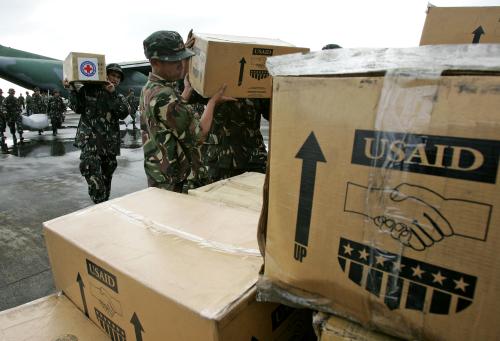A few weeks ago, Duke Professor Indermit Gill prophesied in a Brookings blog post that 2018 will herald the end of aid just as we hosted a roundtable of experts from civil society, multilateral institutions, and former government officials with Charlotte Petri Gornitzka, chair of the Organization for Economic Cooperation and Development’s (OECD) Development Assistance Committee (DAC), the group of high-income countries that provide that aid.
The DAC, the arbiter and guardian of official development assistance (ODA), is increasingly at risk of obsolescence. Even as levels of ODA have continued to increase—it reached a new annual peak of $142.6 billion in 2016—that assistance makes up an ever-smaller proportion, now less than 10 percent, of the financial flows into developing countries. Aid has become a victim of its own success in creating the environment for other types of investment.
In recent years, the DAC has been bogged down in technical disputes over its accounting, while overtaken in prominence by more visible, inclusive forms of global cooperation, such as the creation of the Sustainable Development Goals (SDGs) under the umbrella of the United Nations.
Chair Petri Gornitzka has laid out a reform agenda to adapt the committee to current global realities. President Donald Trump’s remarks from his recent State of the Union address, in which he proposed legislation to link U.S. foreign assistance to whether countries vote with the U.S. at the U.N., demonstrates the intensity of the headwinds. Aid is under pressure—from within as much as from without—with prominent DAC donors either feeling tapped out (even if they have formidable constituencies for providing aid) or testing the limits of the aid effectiveness principles that serve as the DAC’s cornerstone.
Our roundtable discussion, however, highlighted that an uncertain environment and even lack of consensus provides the DAC a basis for renewal. Its core constituency are the development ministers of OECD countries, political leaders who would benefit from a safe space to strengthen the case to their publics and political masters regarding the importance of investing in global development and coordinating their action to maximize returns.
The development narrative is practically begging for an update to make it relevant in the current political context. Even the words matter: Most non-experts would have trouble explaining what is meant by “development cooperation,” the term at the heart of how the DAC describes its primary preoccupation.
As an example, both Ambassador Mark Green, the administrator of U.S. Agency for International Development, and Penny Mordaunt, the United Kingdom secretary of state for development, are emphasizing that successful aid should lead to its own demise, touting approaches that would position recipient countries to shoulder an increasing share of responsibility over time.
Putting this idea of transition at the center of their strategies has the potential for deepening and sharpening development theory, practice, and impact—or being used disingenuously as an excuse for slashing budgets. The DAC offers a frank, political forum to get it right.
The DAC is also well-positioned to provide leadership in shepherding the shift from development aid to development finance, the much broader array of tools and capital that includes both public and private resources that will be necessary to achieve the scale of the SDGs.
The DAC’s concern about standardizing measurement and ensuring that the accounting is credible is well-placed, as donors are making claims about public resources unleashing private investment as they seek as much political credit as possible. To many outside observers, DAC members are twisting themselves into a pretzel, trying to find ways to make their aggregate numbers look good. It begs the question: How is all this financial innovation addressing market failures and benefiting the poorest?
Spending so much time trying to account favorably for the inputs blurs the focus. One of the DAC’s comparative advantages is (or ought to be) a central emphasis on development outcomes and effectiveness, including the key ingredients that make its development agenda so powerful. The DAC’s agenda is grounded in the OECD’s roots in promoting democratic institutions, well-being, and human rights. It was a critical step forward to have such values integrated into the new global consensus on development, evidenced, for example, by SDG 5 on gender equality and SDG 16 on peace, justice, and strong institutions.
Such a central focus on sustained and sustainable development impact, and the values that undergird it, should continue to set the DAC apart. Its leadership can demonstrate the value-add of development assistance provided by donors that uphold democratic principles, human rights, transparency, and accountability as their guide.
The DAC, as a closed club of developed countries, has struggled with the question of how best to open up or include new actors such as South-South providers (middle-income countries helping their counterparts) and non-DAC donors, especially China, which will invest trillions in countries throughout Asia and Africa through its One Belt, One Road initiative. However, perhaps that’s the wrong question—it may be more beneficial to reinforce the unique advantages of its approach and draw distinctions with the alternatives.
This summer will mark the 50th anniversary of Tidewater, the annual off-the-record retreat of DAC development ministers, so-named because the initial gathering was hosted by the U.S. at the Tidewater Inn on the eastern shore of Maryland. It will be an important opportunity for the members to renew and elevate the unique political leadership that the DAC can provide in advancing the development enterprise and achieving the SDGs. The DAC has too much to offer for this particular Tidewater gathering to lead to a valedictory.






Commentary
In defense of traditional aid
February 12, 2018